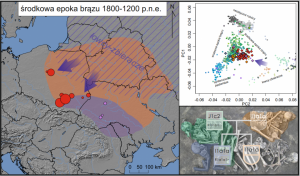The researchers observed a demographic shift as a result of the migration of communities (mainly men) of the so-called Forest Subneolithic from north-eastern Europe, subsequently associating with Early Bronze Age populations settling in central and eastern Europe, genetically related to steppe ancestors from the Black Sea-Caspian region and descendants of Neolithic farmers.
"Analysis of 91 nuclear genomes from the territories of present-day Poland and Ukraine revealed the presence of an increased number of genetic components representing hunter-gatherer populations and a radical change in the frequency of certain Y-DNA haplogroups," says Dr Maciej Chyleński of the Fossil DNA Laboratory of the Institute of Human Biology and Evolution, Faculty of Biology.
"In the mass graves, which are characteristic for representatives of the so-called Canean cultural circle, we have documented examples of the deceased closely related mainly in the male line," adds Prof. Przemysław Makarowicz of the Faculty of Archaeology.
"The research also indicates patrilocal social organisation in this period, i.e. the residence of new families together with the male family," adds Dr Anna Juras from the Fossil DNA Laboratory of the Institute of Human Biology and Evolution of the Faculty of Biology.


